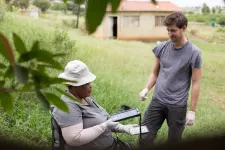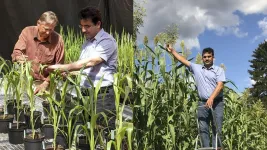INFORMATION:
AI app could help diagnose HIV more accurately
Pioneering technology developed by UCL (University College London) and Africa Health Research Institute (AHRI) researchers could transform the ability to accurately interpret HIV test results, particularly in low- and middle-income countries
2021-06-18
(Press-News.org) Pioneering technology developed by UCL (University College London) and Africa Health Research Institute (AHRI) researchers could transform the ability to accurately interpret HIV test results, particularly in low- and middle-income countries.
Academics from the London Centre for Nanotechnology at UCL and AHRI used deep learning (artificial intelligence/AI) algorithms to improve health workers' ability to diagnose HIV using lateral flow tests in rural South Africa.
Their findings, published today in Nature Medicine, involve the first and largest study of field-acquired HIV test results, which have applied machine learning (AI) to help classify them as positive or negative.
More than 100 million HIV tests are performed around the world annually, meaning even a small improvement in quality assurance could impact the lives of millions of people by reducing the risk of false positives and negatives.
By harnessing the potential of mobile phone sensors, cameras, processing power and data sharing capabilities, the team developed an app that can read test results from an image taken by end users on a mobile device. It may also be able to report results to public health systems for better data collection and ongoing care.
Lateral flow tests - or rapid diagnostic tests (RDTs) - have been used throughout the COVID-19 pandemic and play an important role in disease control and screening.
While they provide a quick and easy way of testing outside of clinical settings, including self-testing, interpretation of test results can sometimes be challenging for lay people.
Self-testing relies on people self-reporting results for clinical support and surveillance purposes. Evidence suggests that some lay caregivers can struggle to interpret RDTs because of colour blindness or short-sightedness.
The new study examined whether an AI app could support HIV testing decisions made by fieldworkers, nurses and community health workers.
A team of more than 60 trained field workers at AHRI first helped build a library of more than 11,000 images of HIV tests taken in various conditions in the field in KwaZulu-Natal, South Africa, using a mobile health tool and image capture protocol developed by UCL.
The UCL team then used these images as training data for their machine-learning algorithm. They compared how accurately the algorithm classified images as either negative or positive, versus users interpreting test results by eye.
Lead author and Director of i-sense Professor Rachel McKendry (UCL London Centre for Nanotechnology and UCL Division of Medicine) said: "This study is a really strong partnership with AHRI that demonstrates the power of using deep learning to successfully classify 'real-world' field-acquired rapid test images, and reduce the number of errors that may happen when reading test results by eye. This research shows the positive impact the mobile health tools can have in low- and middle-income countries, and paves the way for a larger study in the future."
A pilot field study of five users of varying experience (ranging from nurses to newly trained community health workers) involved them using the mobile app to record their interpretation of 40 HIV test results, as well as capture a picture of the tests to automatically be read by the machine learning classifier. All participants were able to use the app without training.
The machine learning classifier was able to reduce errors in reading RDTs, correctly classifying RDT images with 98.9% accuracy overall, compared to traditional interpretation of the tests by eye (92.1%).
A previous study of users of varying experience in interpreting HIV RDTs showed the accuracy varied between 80% and 97%.
Other diseases that RDTs could support include malaria, syphilis, tuberculosis, influenza and non-communicable diseases.
First author Dr Valérian Turbé (UCL London Centre for Nanotechnology) and i-sense researcher in the McKendry group said: "Having spent some time in KwaZulu-Natal with fieldworkers organising the collection of data, I've seen how difficult it is for people to access basic healthcare services. If these tools can help train people to interpret the images, you can make a big difference in detecting very early-stage HIV, meaning better access to healthcare or avoiding an incorrect diagnosis. This could have massive implications on people's lives, especially as HIV is transmissible."
The team now plan a larger evaluation study to assess the performance of the system, with users of differing ages, gender and levels of digital literacy.
A digital system has also been designed to connect to laboratory and healthcare management systems, where RDT deployment and supply can be better monitored and managed.
AHRI Clinical Research Faculty Lead, Professor Maryam Shahmanesh (UCL Institute for Global Health), said: "Trials we have conducted in the area have found that HIV self-testing is effective in reaching large numbers of adolescents and young men. However, HIV self-testing has been less successful in linking people to biomedical prevention and treatment. A digital system that connects a test result and the person to healthcare, including linkage to antiretroviral therapy and pre-exposure prophylaxis, has the potential to decentralise HIV prevention and deliver on UNAIDS goals to eliminate HIV."
Dr Kobus Herbst, AHRI's Population Science Faculty lead, added: "This study shows how machine learning approaches can benefit from large and diverse datasets available from the global South, but at the same time be responsive to local health priorities and needs."
The researchers also suggest that real-time reporting of RDT results through a connected device could help in workforce training and outbreak management, for example by highlighting 'hotspots' where positive test numbers are high. They are currently extending the approach to other infections including COVID-19, and non-communicable disease.
Former AHRI Director Professor Deenan Pillay (UCL Infection & Immunity), said: "As digital health research moves into the mainstream, there remain serious concerns that those populations most at need around the world will not benefit as much as those in high income settings. Our work demonstrates how, with appropriate partnerships and engagement, we can demonstrate utility and benefit for those in low- and middle-income settings."
ELSE PRESS RELEASES FROM THIS DATE:
Footprints discovered from the last dinosaurs to walk on UK soil
2021-06-18
Footprints from at least six different species of dinosaur - the very last dinosaurs to walk on UK soil 110 million years ago - have been found in Kent, a new report has announced.
The discovery of dinosaur footprints by a curator from Hastings Museum and Art Gallery and a scientist from the University of Portsmouth is the last record of dinosaurs in Britain.
The footprints were discovered in the cliffs and on the foreshore in Folkestone, Kent, where stormy conditions affect the cliff and coastal waters, and are constantly revealing new fossils.
Professor of Palaeobiology, David Martill, said: "This is ...
Phytoplankton -- the discovery of a missing link
2021-06-18
Biologists have identified a family of algae as a living missing link in the microscopic domain.
Over the course of evolutionary time, marine microorganisms have undergone an immense range of diversification. This applies in particular to the group known as dinophytes. Also known as dinoflagellates, these unicellular algae can account for a significant fraction of the phytoplankton in the oceans, and their ecological and economic significance is correspondingly high. A team of researchers led by Ludwig-Maximilians-Universitaet (LMU) in Munich biologist Professor Marc Gottschling now reports the identification of a missing link between the two major phylogenetic groups of dinophytes, ...
Irritable bowel syndrome endoscopically identifiable from mucosal biofilms
2021-06-18
One in six women and one in twelve men in Austria suffers from some form of IBS - therefore around one million people in all. Using currently available techniques, it is only possible to diagnose IBS by a process of elimination. Most people suffering from irritable bowel syndrome only go to their doctor when they have severe symptoms such as constipation, diarrhoea, abdominal pain, or a change in bowel motion. Researchers from the Department of Medicine III of the Medical University of Vienna and the University of Vienna have now shown that, in most cases, IBS is associated with bacterial biofilms ...
Baseline medication use is associated with COVID-19 severity in people with rheumatic diseases
2021-06-18
Due to sample size limitations, previous studies of DMARD use and COVID-19 outcomes have combined several different rheumatic diseases and medications, and investigated a single outcome- for example, the risk of hospitalization. EULAR has given financial support to a global project collecting information on SARS-CoV-2 infection in people with rheumatic diseases. The COVID-19 Global Rheumatology Alliance physician-reported registry launched in March 2020 to collect data on adults with rheumatic disease and confirmed or presumptive COVID-19.
This analysis from Jeffrey Sparks, Zachary Wallace, and colleagues aimed to investigate the associations between baseline use of biologic or ...
Climate warming can influence fungal communities on oak leaves across the growing season
2021-06-18
Climate warming plays a larger role than plant genes in influencing the number and identity of fungal species on oak leaves, especially in autumn. Recently published in the journal New Phytologist, this research by ecologists sheds light on how warming and tree genes affect the dynamics of fungal communities across the season.
"One of our major findings was that elevated temperature decreased the number of fungal species and changed their community composition, especially in the late season" says Maria Faticov, a researcher at the Department of Ecology, Environment and Plant Sciences (DEEP) at Stockholm University.
Plants host thousands of microscopic organisms and leaves are no exception. ...
First trial of faecal microbiota transplantation for people with active peripheral psoriatic arthritis shows no advantage
2021-06-18
In this proof-of-concept study, Maja Skov Kragsnaes and colleagues evaluated efficacy and safety of FMT in people with psoriatic arthritis (PsA). PsA is an inflammatory arthritis that causes a person's joints to become stiff and painful. It is often found people with the skin condition psoriasis, and there is also a link between PsA and inflammatory bowel disease or gastrointestinal symptoms.
This double-blind, parallel-group, sham-controlled, superiority trial randomly allocated31adults with active peripheral PsAd espite ongoing treatment with methotrexate to one gastroscopic-guided FMT procedure, or sham transplantation into the duodenum. The transplants (50 g faeces) came from one of four healthy, anonymous stool ...
Wind and waves: A step toward better control of heavy-lift crane vessels
2021-06-18
Massive heavy-lift crane vessels, capable of hauling thousands of tons, navigate the rough waves and strong winds offshore to construct wind turbines and oil fields in the ocean. An international team of researchers has developed a new modeling system to help improve the control, and ultimately the safety, of such vessels. They published their approach in the April issue in IEEE/CAA Journal of Automatica Sinica.
"Dynamic positioning allows the ship to stay fixed in a certain location, by acting on the thruster," said paper author Simone Baldi, professor in the School of Mathematics and School of Cyber Science and Engineering, Southeast University in China, and guest with the Delft Center for System and Control, Delft University of Technology in the Netherlands.
This positioning operation ...
Sweet sorghum: Sweet promise for the environment
2021-06-18
Sweet sorghum can be used to produce biogas, biofuels, and novel polymers. In addition, it can help replace phosphate fertilizers. A new sweet sorghum variety developed at Karlsruhe Institute of Technology (KIT) accumulates particularly high amounts of sugar and thrives under local conditions. As the scientists reported in the Industrial Crops & Products journal, sugar transport and sugar accumulation are related to the structure of the plants' vessels. This was the result of a comparison between sweet and grain sorghums. (DOI: 10.1016/j.indcrop.2021.113550)
As the world's population grows, the demand for food, raw materials, and energy is also on the rise. This increases the burden on the environment and the climate. One strategy to reduce greenhouse gas emissions is to grow so-called ...
Imaging at the tip of a needle
2021-06-18
Scientists have developed a new technique that could revolutionise medical imaging procedures using light.
A team of physicists, led by Dr David Phillips from the University of Exeter, have pioneered a new way in which to control light that has been scrambled by passage through a single hair-thin strand of optical fibre. These ultra-thin fibres hold much promise for the next generation of medical endoscopes - enabling high-resolution imaging deep inside the body at the tip of a needle.
Conventional endoscopes are millimetres wide and have limited resolution - so cannot be used to inspect individual cells. Single optical fibres are approximately 10x narrower and can enable much higher-resolution imaging - enough to examine the features of individual ...
Proliferation of electric vehicles based on high-performance, low-cost sodium-ion battery
2021-06-18
Various automobile companies are preparing to shift from internal combustion (IC) engine vehicles to electric vehicles (EVs). However, due to higher cost, EVs are not as easily accessible to consumers; hence, several governments are subsidizing EVs to promote sales. For EV costs to compete with those of IC engine vehicles, their batteries, which account for about 30% of their cost, must be more economical than that of IC-based vehicles.
The Korea Institute of Science and Technology (KIST) has announced that Dr. Sang-Ok Kim's team at the Center for Energy Storage Research had developed a novel, high-performance, economical anode material for use in sodium-ion secondary batteries, which are ...
LAST 30 PRESS RELEASES:
Do our body clocks influence our risk of dementia?
Anthropologists offer new evidence of bipedalism in long-debated fossil discovery
Safer receipt paper from wood
Dosage-sensitive genes suggest no whole-genome duplications in ancestral angiosperm
First ancient human herpesvirus genomes document their deep history with humans
Why Some Bacteria Survive Antibiotics and How to Stop Them - New study reveals that bacteria can survive antibiotic treatment through two fundamentally different “shutdown modes”
UCLA study links scar healing to dangerous placenta condition
CHANGE-seq-BE finds off-target changes in the genome from base editors
The Journal of Nuclear Medicine Ahead-of-Print Tip Sheet: January 2, 2026
Delayed or absent first dose of measles, mumps, and rubella vaccination
Trends in US preterm birth rates by household income and race and ethnicity
Study identifies potential biomarker linked to progression and brain inflammation in multiple sclerosis
Many mothers in Norway do not show up for postnatal check-ups
Researchers want to find out why quick clay is so unstable
Superradiant spins show teamwork at the quantum scale
Cleveland Clinic Research links tumor bacteria to immunotherapy resistance in head and neck cancer
First Editorial of 2026: Resisting AI slop
Joint ground- and space-based observations reveal Saturn-mass rogue planet
Inheritable genetic variant offers protection against blood cancer risk and progression
Pigs settled Pacific islands alongside early human voyagers
A Coral reef’s daily pulse reshapes microbes in surrounding waters
EAST Tokamak experiments exceed plasma density limit, offering new approach to fusion ignition
Groundbreaking discovery reveals Africa’s oldest cremation pyre and complex ritual practices
First breathing ‘lung-on-chip’ developed using genetically identical cells
How people moved pigs across the Pacific
Interaction of climate change and human activity and its impact on plant diversity in Qinghai-Tibet plateau
From addressing uncertainty to national strategy: an interpretation of Professor Lim Siong Guan’s views
Clinical trials on AI language model use in digestive healthcare
Scientists improve robotic visual–inertial trajectory localization accuracy using cross-modal interaction and selection techniques
Correlation between cancer cachexia and immune-related adverse events in HCC
[Press-News.org] AI app could help diagnose HIV more accuratelyPioneering technology developed by UCL (University College London) and Africa Health Research Institute (AHRI) researchers could transform the ability to accurately interpret HIV test results, particularly in low- and middle-income countries




